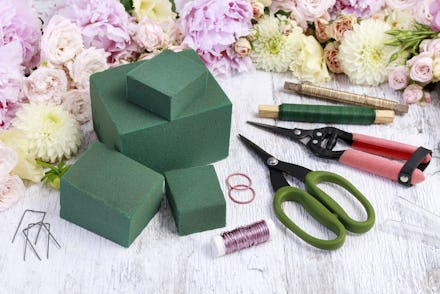The foam in your holiday bouquet might be harming sea creatures

Floral foam is a common material florists use to make their floral arrangements beautiful. It's a light, Styrofoam-like, green base that absorbs water like a sponge, can maintain the acidity of cut flowers, and keeps blossoms in place without using dirt. It has also doubled as one of the latest trends in Instagram ASMR videos due to the velvety, crispy sounds produced when crushing it. But the use of this foam comes with a heavy environmental price; a study by researchers at RMIT University have found that floral foam contributes to microplastic pollution, which is then ingested by aquatic animals.
The study set out to observe the effects of floral foam pollution on marine life. The tests were done on invertebrates that ate the foam in various, unique ways. The species showed signs of stress and toxicity upon ingestion, with some more affected than others. The study also noted that microplastics from floral foam leaked "twice as much" toxic compounds than "regular foam microplastics." This means floral foam is potentially "more toxic to aquatic invertebrates than [leaked chemicals] from other plastic families."
The research team was the first to look at the environmental effects of the foam, but they hope they won't be the last. Especially considering that each foam block is equal, in weight, to approximately 10 plastic grocery bags.
"For an industry that seeks to celebrate nature, we are actually adding to environmental problems when using this product," said Rita Feldmann, founder of the Sustainable Floristry Network, to Phys.org. The Sustainable Floristry Network is an organization that hopes to encourage florists to adopt more sustainable practices for their businesses.
According to a survey of over 1,200 florists, conducted by the Sustainable Floristry Network, 72 percent of florists who use the foam dispose of it by dumping it down the sink. This is also the disposal of choice by ASMR video creators on Instagram, who typically dump an extra load of glitter (which are also microplastics) on top of the foam before crushing it. With these videos garnering as many as 70 million views, concerned researchers and environmentalists believe people still don't truly understand the impact and wastefulness of shoving floral foam down the drain.
"Disposal issues have stemmed directly from a lack of user information about the product on packaging and at the point of sale," Feldmann said. "For the past 60 years, florists all over the world have been pouring it down the sink or putting it in the soil" without realizing its effects on the environment. And it's not all on florists, either — other uses, such as its use in videos and in coffins, can contribute to the damage as well.
Feldmann hopes the findings from the study will encourage more florists to consider more sustainable and old-school methods of flower arrangements. Further research can show us how floral foam affects larger creatures, like fish and other vertebrates, as well. And whatever affects the fish will affect us, too, since we eat them. As studies continue on the effects of microplastics in the environment and on humans, perhaps this information will get people to stop and think about what they use (and watch) in the future.